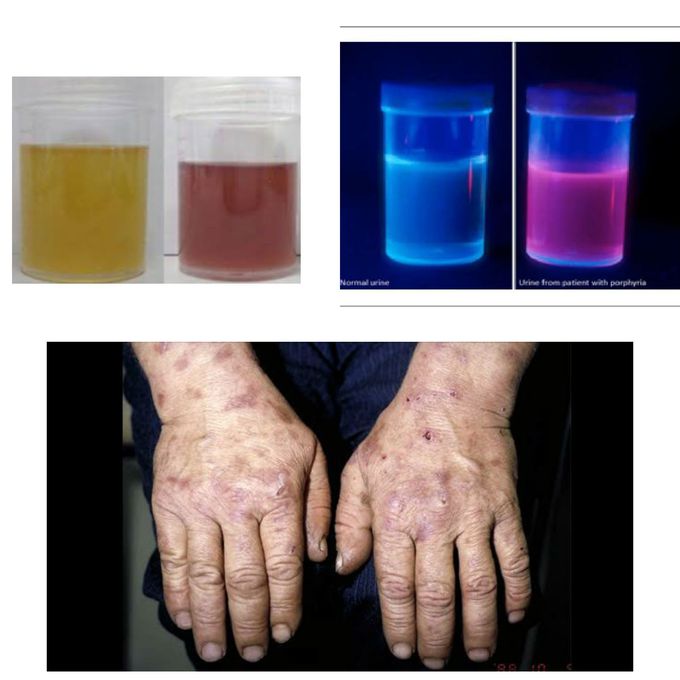


Porphyria cutanea tarda
Porphyrias are rare, inherited or sometimes aquired, disorders which result from a defect in the heme synthesis pathway due to an enzyme deficiency. This defeciency leads to the accumulation and increased excretion of porphyrins or their precursors. Whenever there is an enzyme defect leading to accumulation of tertrapyrrole rings, patients present with photosensitivity. Porphyria cutanea tarda, the most common porphyria, belongs to the group of chronic hepatitic porphyrias. There is a deficiency of enzyme uroporphyrinogen decarboxylase. Factors like exposure to sunlight, hepatic iron overload, estrogen therapy, infections like hepatitis B or C and HIV and alchohol ingestion can exacerbate the expression of disease. Patients usually present during their 4th or 5th decade with photosensitivity, skin lesions like slowly healing skin eruptions and blisters, crusting and scarring of skin, hyperpigmentation, increased hair growth, especially facial. Urine is red to brown in natural light and pink or red in fluorescent light. Treatment may include phlebotomy, use of iron chelators or low doses of anti-malarial drugs like chloroquine or hyrdroxychloroquine. PCT is a risk factor for developing liver cirrhosis hence, life style changes should be adapted like avoiding alcohol and smoking, avoiding sunlight and application of sunscreen. Intake of estrogen should also be discontinued. Image via: https://images.app.goo.gl/66wCBZ1VQFzERHKW9 https://images.app.goo.gl/zWPzUSXUkwdGZpLy7 https://images.app.goo.gl/3pVoW1XruWaqF9hXA
I was diagnosed as a Hepatitis B carrier in 2015, with early signs of liver fibrosis. At first, antiviral medications helped control the virus but over time, resistance developed, and the effectiveness faded. I began to lose hope. In 2021, I discovered NaturePath Herbal Clinic despite my skepticism, I decided to give their herbal treatment a try.To my surprise, after just six months, my blood tests came back negative for the virus.It was nothing short of life-changing.I never expected such incredible results from a natural treatment. But it not only cleared the virus it restored my hope, my health, and my peace of mind.If you or someone you know is battling Hepatitis B, I truly encourage you to explore the natural healing path offered by NaturePath Herbal Clinic. It gave me a second chance and it might do the same for you.www.naturepathherbalclinic.com info@naturepathherbalclinic.com
Living with HIV was one of the hardest experiences of my life. The fatigue, the emotional toll, and the uncertainty about the future weighed on me every single day. I had tried many treatments and medications, but nothing seemed to restore my health or energy the way I hoped.Out of both hope and desperation, I came across NaturePath Herbal Clinic. At first, I was skeptical but something about their natural approach and the powerful stories I read gave me the courage to try one more time.I began their herbal treatment program, and within a few weeks, I noticed small but meaningful changes more energy, better sleep, and a stronger immune system. Over the months, those improvements only grew. Today, I can truly say my life has changed. I feel healthier, more balanced, and finally in control of my well-being again.This isn’t just a testimony it’s a heartfelt recommendation to anyone living with HIV or any chronic condition. Don’t give up hope. I’m so grateful I gave NaturePath Herbal Clinic a chance. Visit their website to learn more: www.naturepathherbalclinic.com Email: info@naturepathherbalclinic.com




